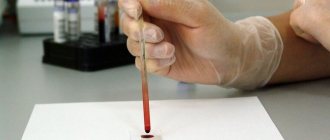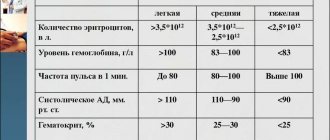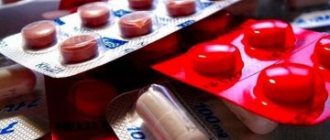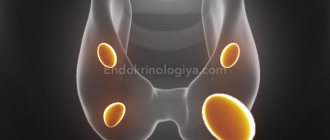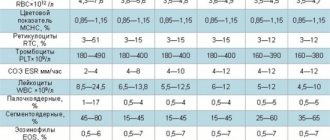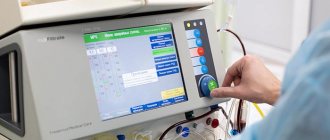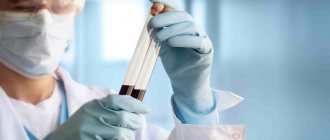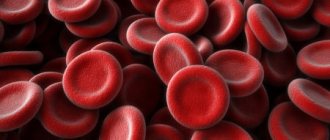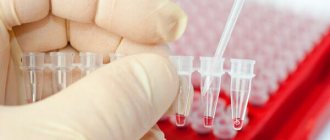Indications for use
The most common symptoms that allow a doctor to prescribe a rheumatic test are:
- Joint pain, swelling.
- Impaired joint function.
- Body aches when weather conditions change, as well as pain in the lumbar back.
- Frequent and prolonged headaches.
- Low-grade fever.
Also grounds for prescribing an analysis are suspicions of:
- Systemic connective tissue diseases (systemic lupus erythematosus, rheumatoid arthritis and others).
- Malignant tumors.
- Liver diseases.
- Sepsis.
- Chronic tonsillitis.
Diagnostic criteria
Rheumatoid arthritis is characterized by erosive and destructive lesions of predominantly small peripheral joints. The disease is dangerous due to the gradual destruction of joints and disorders of the internal organs. A decrease in their functional activity can be tracked by changes in the composition of biological fluids - blood, urine, synovium. Often, biochemical studies help to definitively make a diagnosis of rheumatoid arthritis, confirming the results of radiography, MRI, CT, and arthroscopy. If you suspect the development of pathology, the following tests are necessary:
- general urinalysis;
- general blood test, including calculation of ESR (erythrocyte sedimentation rate);
- biochemical blood test to determine the levels of liver enzymes, creatinine, C-reactive protein;
- detection of rheumatoid factor, anticitrullinated and antinuclear antibodies;
- identifying markers of hepatitis development as a differential diagnosis of reactive arthritis.
These are the most common methods for clinical detection of joint disease. Diagnosis of rheumatoid arthritis using laboratory tests simultaneously allows you to assess your overall health.
Preliminary preparation
For the most productive research the day before, you must follow several rules:
- The last meal is taken 7-10 hours before the analysis.
- During the day you need to avoid eating fatty foods, fried foods, drinking alcohol, and also exclude tea and coffee from your diet.
- During the day before the procedure, you must avoid physical activity.
It is advisable to adhere to these rules, otherwise the procedure will need to be rescheduled to avoid getting an erroneous result.
Basic indicators and their normal values
Due to the fact that such an analysis includes a number of laboratory tests, there is no rheumatic test standard as such. To determine the result, the indicators of each criterion should be taken into account separately.
Rheumatoid factor (RF)
Rheumatoid factor is a specific autoantibody that reacts to its own modified immunoglobulins G, entering into a destructive reaction with them. This happens, for example, under the influence of a virus.
A negative indicator or a result equal to 0 is considered normal.
However, there is an upper limit of the conditional norm, within which a test for the presence of this criterion is considered negative:
- Adults - up to 13.9 IU/ml.
- Children - less than 12.3 IU/ml.
The age group of 50 and older is an exception, since due to age the result will be positive.
Also, the detection of rheumatoid factor is influenced by violation of the rules of preparation for the rheumatoid test, for example, eating fatty foods.
Antistreptolysin-O (ASO, ASLO)
An increase in the indicator is usually caused only by the appearance of a streptococcal infection in the body. As a reaction to its occurrence, antibodies are produced, whose prolonged contact with the infection causes pathologies.
A deviation from the normal level of antistreptolysin in the blood indicates the presence of a focus of streptococcal infection, or a recent illness.
Standard for this criterion:
- Children under 14 years old - up to 148 U/ml.
- Adults and adolescents over 14 years of age - up to 198 U/ml.
Factors that can influence deviation from the norm:
| Change | Causes |
| Promotion | Purulent inflammation |
| ARVI | |
| Excessive exercise | |
| High blood cholesterol | |
| Kidney or liver diseases | |
| Demotion | Taking medications containing hormones |
| Antibiotics |
C-reactive protein/protein (CRP, CRP)
Monitoring the dynamics of changes in the level of this indicator in the blood helps to quickly track the moment of exacerbation of a number of diseases. For example, a sharp jump in the content of this element may indicate the presence of a malignant neoplasm or the development of myocardial infarction.
A normal indicator of the concentration of CRP in the blood is considered to be in the range of 0-6 mg/l.
However, the increase in protein content can be affected by: obesity, the presence of unhealed skin lesions, recent surgery, nicotine consumption and hormonal medications.
Factors that can reduce C-reactive protein levels include steroid use, hemolysis, and high blood fat levels.
Total protein
The level of protein content is a criterion for the health of the body as a whole. Deviations from the normal boundary in one direction or another indicate the possibility of the development of pathologies. The norm is considered to be the individual protein concentration (grams) per liter of blood for each age group.
| Age | Norm |
| Newborns | 46-71 grams/liter |
| Infants under 1 year | 51-76 grams/liter |
| Children from 3 years old | 61-82 grams/liter |
| Adults | 65-88 grams/liter |
| Aged people | 61-81 grams/liter |
Several factors can influence a decrease or increase in the indicator. For example, increased protein content is affected by dehydration that occurs due to prolonged diarrhea. Taking hormonal medications may also have an effect.
In addition, the following diseases can contribute to exceeding the norm:
- Infectious diseases.
- Hodgkin's disease.
- Liver diseases (hepatitis, cirrhosis).
- Blood poisoning.
- Myeloma, Waldenström's disease.
The following can contribute to the reduction: fasting, excessive physical activity, and drinking plenty of fluids (from 3 liters per day).
Albumen
The proteins of the albumin fraction in the body are proportionally correlated with the proteins of the globulin fraction. This balance is disrupted when pathology occurs. Factors influencing the excess of the indicator include taking medications containing hormones, as well as insufficient fluid intake.
Also, diseases can affect deviations from the norm to a greater extent:
- Liver diseases (hepatitis, cirrhosis).
- Nephritis and diabetes.
- Intestinal obstruction.
- Cholera.
- Multiple myeloma; Waldenström's disease.
If the result is reduced, the factors leading to this may be: diet, tobacco use, pregnancy or lactation.
Uric acid (UA)
If the process of removing uric acid from the body is disrupted, there is a danger of increasing the level of salts in the body, which, in turn, leads to the development of gout and kidney failure.
Normal indicators are presented in the table:
| Gender/Age | Norm |
| Women | 0.15-0.45 mmol/liter |
| Men | 0.17-0.52 mmol/liter |
| Children | 0.12-0.3 mmol/liter |
Also, the value of this indicator depends on the presence of excessive physical activity and the amount of muscle mass in the body. The greater these criteria, the higher the indicators.
An increased level of this substance in the blood can be influenced by: excess weight, daily inclusion of fatty and high-carbohydrate foods in your diet, and dehydration.
Circulating immune complexes
These are complexes formed from emerging antigens, immunoglobulin proteins and complement.
Normal value for this criterion: 31-91 U/ml.
Greater deviations from the norm can be caused by the use of a number of medications:
- Preparations containing hormones.
- "L-asparaginase".
- Medicines containing narcotic substances.
- Anticonvulsants.
A course of chemotherapy or the use of antidepressants may contribute to a decrease in indicators.
Antibodies to cyclic citrullinated peptide (A-CCP, A-CCP)
The presence of these antibodies is a clear sign of the development or presence of prerequisites for the appearance of rheumatoid arthritis.
The normal level of antibodies is within 20 U/l.
Norms of blood parameters
There are generally accepted standards for rheumatic complex indicators that help confirm or refute the presence of pathology in the body.
Table “Acceptable values of rheumatic tests”
| Indicators and age group | Meaning |
| ASLO | |
| In adults | From 0 to 203 U/ml |
| In children (up to adolescence) | Up to 151 U/ml |
| Rheumatic factor | |
| In adults | Up to 15 IU/ml |
| In children (up to 12 years old) | Up to 13 IU/ml |
| C-reactive protein (regardless of age) | 0 (an indicator when the rheumatic test is positive, but not more than 5 IU/ml can also be considered a negative value) |
| Albumen | |
| In adults under 60 years of age After 60 years of age | 35–50 g/l 33–49 g/l |
| In children (up to 14 years old) | 37–54 g/l |
| Total protein | |
| In adults from 15 to 60 years | 65–85 g/l |
| In older people (after 60 years) | 63–84 g/l |
| The child is under one year of age | From 46 to 74 g/l |
| From one to 4 years | 60–76 g/l |
| 5-15 years | 58–77 g/l |
Values may vary slightly depending on laboratory, equipment and starting materials for analysis. Therefore, many research institutions indicate their limit norms for rheumatic test indicators on a special form.
How to submit it?
To perform a rheumatological test, venous blood is required. Biomaterial is collected for analysis of the main factors once. Repeated blood sampling is necessary only if an increased level of ASLO (antistreptolysin) is detected. It is performed no earlier than a week after the first blood donation.
Children are also prescribed blood donation for a rheumatic test. Here the results are interpreted somewhat differently: in school-age children, antistreptolysin levels are above average, which is considered quite normal due to their age.
In pregnant women, the results of a number of tests (in particular, analysis of albumin levels) may be underestimated.
Preparation for delivery
These precautions increase the possibility of obtaining reliable results of the analysis of rheumatic tests:
- It is recommended to take tests first thing in the morning and on an empty stomach.
- You can only drink still water the day before, and you can eat it 8 hours before the test.
- It is better to donate blood before starting medication treatment, as they can significantly distort test results. Otherwise, it is better to postpone the examination.
- Subsequently, at least 2 weeks should pass between the end of taking the drugs and the delivery of rheumatic tests.
Decoding the results
If the norms are exceeded according to three main criteria, we can conclude that certain diseases are present.
The result is positive
| High level of ASLO | High RF level | High CRP level |
| Rheumatoid arthritis | Rheumatoid arthritis | Inflammatory processes caused by diseases of the joints or bone tissue |
| Chronic tonsillitis | Infectious diseases (tuberculosis, influenza, rubella) | |
| Scarlet fever | Malignant tumors | |
| Osteomyelitis | Polymyositis | |
| lupus erythematosus | ||
| Injuries to the walls of blood vessels |
The results of rheumatic tests, as a rule, are provided to the patient a day after the biomaterial is submitted to them. Interpretation of results should only be carried out by a qualified specialist.
The result is negative
The result is considered negative when the values of the main indicators are within the normal range. This is not a reason to conduct a repeat rheumatic test.
Low results can also be affected by factors such as pregnancy, nervous or physical exhaustion.
What does a blood test show for rheumatic tests?
To determine the level of spread of inflammatory processes in the tissues of the body (joints, organs), their exact location and type, a special study is used - analysis for rheumatic tests. Let’s take a closer look at what it is and when it is prescribed.
Analysis for rheumatic tests is carried out to identify inflammatory processes in body tissues
